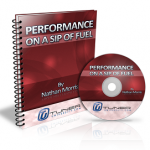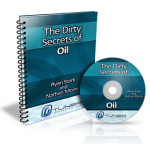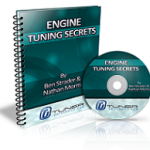If I could do only 5 performance modifications to a car, with cost being a consideration, and perhaps also wanting to strongly avoid "ruining" the car, what would I do?
Tires
As discussed in a previous article, tires are simply put, the most important part on your car. They are what ultimately decide how fast your car can accelerate, stop, and corner. Everything else is only a detail in the equation. They are also the key to many ride comfort issues for those of you trying to soften out harsher rides caused by the OEM tires.
It should be said though that tire selection certainly has a lot to do with application. Running an extreme performance summer tire is great - in the summer, for a car you intend on driving hard through the mountains on nice days or at autocross events. They are not so great as daily driver tires as they do not deal with the rain as well as max performance tires do, and frankly, at the operating temperature of the tires for daily driving - they are going to work better than extreme performance tires too.
On the flip side, if it's cold outside, not running winter oriented tires is going to affect all areas of your cars performance. All season performance tires though may be a good choice when budget is concerned, just stick to the highest performance all seasons you can afford and avoid all seasons completely if you live in an area where temperatures drop routinely below freezing.
The great news is that in the past 5-10 years there have been monumental changes in tire design. You can now get max and extreme performance tires that can give you the grip of yesterday's race only tires. Some newer all season tires can even give you impressive performance all year round despite their necessary compromises.
If you're still running the OEM spec tires that were fitted to your car, it may be a good time to reconsider them when you need new tires, especially if your car was made over 10 years ago.
In the end, fitting some dedicated track tires to a stock car will make for significantly faster track times than any other handling modification in almost all cases. The same would be said for fitting max performance summer tires to a car that came with all seasons. So if you're on a budget and only going to do ONE modification - make really good tires the one.
Sway bars
Sway bars are probably the other 'massive bang for your buck' modification for handling. Sway bars connect the left and ride side of your suspension and function as a torsion spring to tie the two sides together. While fitting sway bars that are too thick can create a car that is very twitchy and dangerous in the wet, fitting larger than factory ones that are a tuned sized can be a great way to improve your handling.
Essentially, when you're driving down the road, the sway bars do not do much of anything. However, when you hit a bump with one wheel, or more specifically when you corner, they effectively stiffen your suspension. This helps in two ways, the first is in keeping the car flat in the corners. A lot of body roll is extremely undesirable in a sporty vehicle as it is very distracting to the driver and it usually means that the tires are not being firmly planted into the ground. It also allows weight transfer to occur much more freely which can unbalance the car and reduce the amount of average grip you can produce in a corner.
Without getting to into the tuning, selection and theory of the sway bars, let's suffice to say that they essentially give you a comfortable ride while giving you a stiffer suspension in the corners. They also do not require you to change your alignment or deal with the expense of changing out springs and shocks.
Whatever you do, do not fit randomly selected sway bars. I see a lot of people buying a front bar and later a rear one, or buying some random front one and then a totally different brand rear one. Unless you have experience tuning a suspension, stick to a matched set of front and rear sways. Preferably, if you have say a base model civic, try to get the matched sways from an Si. The same would be true for many other cars where a factory 'performance' version is available. If not, aftermarket companies can be a good choice. Look for sways developed specifically for your car (not just a good guess at what might work for your car) and if possible avoid polyurethane bushings (unless you want to deal with the occasional squeak from your suspension and a lot of extra greasing being necessary). Most OEM tuners like TRD supply rubber bushings for a reason.
Intake
The intake is almost always a good source for a few extra horsepower. In almost all production cars, the intake is slightly less than optimal - usually due to the concerns of noise and possible water ingestion. If you haven't already, please read some of my articles about using a differential pressure meter to modify your intake system. Don't just buy some pipe with a big $$$ sticker price and slap it on. You'll probably find that while you get a cool noise, in reality, your car is as slow or slower than it was before (in the real world).
But, if done correctly an intake can cost only a few dollars and add a really noticeable improvement to your car. In some cases, you can also see a mild improvement in gas mileage, though, I wouldn't hold your breathe too much on that note.
With intakes, never buy into the high flow filter hype, I've done multiple flow tests on them and I can say without a doubt that any increase in flow is extremely minimal to zero on every car I've tested with a differential pressure meter. What I also can say about "high flow filters" is that these filters may not keep dust and other small elemental dirt out of your engine, so I recommend you stick to the OEM filter which is certainly designed to do this extremely well. Despite what the forums and magazines try to tell you, the OEM filter is not a restriction. It's probably the snorkel leading to the box, or possibly parts of the box or tube running from the box to the throttle body.
Typically the best thing to do is find a way to enlarge the factory entry to the airbox and run a duct to an area of high pressure and low temperature (such as the front grill opening). This is usually possible with a hole saw and a few dollars of dryer hose or if you want something more polished, hose like they use for aftermarket AC (google flexible plastic hose), or perhaps shop vac flxible tubing. Typically this will allow you take advantage of positive pressure building up on the front of the car and reduce intake charge temperatures over the factory design. Read some of my other articles on intakes both past and future to learn other tips for intakes.
Exhaust
The exhaust is the only other place where without a doubt you can pick up some extra power in all vehicles. The reason again being fairly straight forward, cost and noise/vibration.
If you don't want to regret your exhaust, I suggest using a straight through but very large oval muffler. These mufflers are available all over from different companies, but they sound a LOT better than these canister mufflers that most exhausts are capped off with.
I can tell you without a doubt that resonators and large but straight through mufflers do not typically add a lot of restriction to the system. Most resonators add an inconsequential amount of restriction if correctly sized. Certainly not enough to be concerned about. However, they do reduce noise production and increase your comfort level quite a bit. They can also keep you out of trouble with the police and boy racers.
Fitting a 2.5" diameter exhaust pipe is generally sufficient, however, 3" can certainly add more gains. There is no need for 'back pressure' as the forum myth goes, in an ideal world you'd have 0 back pressure, but a back pressure amount of 1-5psi is generally excellent. In another article we'll talk about how you can take actual back pressure measurements to see the need for an exhaust and see improvements.
When possible, stay away from using a 3" pipe however, as the larger the pipe is, the more difficult it is to tune out the noise and vibration from the extra flow. Instead, consider using dual 2.25" pipes which actually have significantly more cross sectional area (and thus flow). The additional weight, even with larger mufflers is typically not enough to offset the horsepower gain under most circumstances.
Price your exhaust out and don't be afraid to use used parts. A great idea is to make friends or at least conversation with a local exhaust shop. Tell them that you're looking for an OEM muffler from a car with more power than yours that will fit your ideal exhaust pipe size. You can often score these mufflers for free in great condition, or for very little cost as the owners typically just throw them away when upgrading.
For example, if you have a 120hp civic, you can certainly count on picking up some power from switch even just the muffler from a 200hp or beyond car. So you might want to look at say a new model Civic Si, or frankly any Honda making decent power with a single muffler. The IS300 muffler is also a very quiet choice and would easily flow enough to gain power on your 120hp civic.
For something like the IS300 making 215hp, a muffler or exhaust setup matching a 300hp car might be the ticket.
Typically the muffler and the pipe size are the issue. Always run a catalytic converter (you can always upsize it!) as otherwise you are looking for trouble and hassle come inspection time. Understand though that catalytic converters do add back pressure to the system, but a correctly sized one with good flow characteristics will keep that addition to a very small amount. The biggest difficulty is making sure that the particular TYPE of catalytic converter you choose flows better than the one its replacing - a very difficult task since no manufacturer really publishes their flow and all of them CLAIM to be "high flow". If in doubt, use an up-sized cat for an almost guaranteed increase in flow.
Brakefluid+Pad Combo
Unless your car was intended to be a track day car, the odds are, your brakes are great - if you only use them occasionally. However, most enthusiasts like aggressive driving through windy roads while many others are probably going a little too fast to begin with and may need to come to a complete stop rather quickly.
Factory pads are designed to be very quiet, have reasonable resistance to heat, work very well almost with no temperature in them, and be reasonably cheap.
However, while rotor upgrades and other braking upgrades can be involved and expensive, a pad upgrade with a change to synthetic brake fluid can be a very inexpensive way to significantly improve braking.
I am cheating a little bit by saying two things here, but I think it's reasonable.
Most cars have sufficiently sized brakes to lock the tires up at highway speeds. This means they are sufficiently powerful. However, the problem comes when the brakes heat up and do not have a chance to cool. Eventually, the pads will become slick rather than biting the rotors and you'll experience brake fade. Brake fade is when you hit the brakes and suddenly the car isn't slowing down as fast as it usually does, or, worse, you have complete brake failure.
In high school, I remember taking an aggressive drive through some mountain roads near my home town. I remember the drive rather well as on the way down the mountain I began to experience very dramatic brake fade, with no where to pull over and with a rather steep grade.
I do not know what angel was looking after me that day, but somehow I made it down the mountain without total brake failure. I learned that day for the first time that brake fade is not only a very real problem, but one you certainly want to avoid under all costs. Murphy's law says you'll experience it at the worst possible time, so, prepare ahead of time.
Brake pads are often replace on cars, so when your brakes wear out, consider a Hawk HPS brake pad or something similar. Make sure that the performance pad you choose has a high range of operating temperatures. You do not want a race pad which works at 800 degrees but not at all where your cars brakes usually operate (probably more like 250 degrees Fahrenheit). You want a pad that works on the street but can get pretty hot before it gives up.
The fluid part of this modification is as cheap or as expensive as you want it to be, but honestly, it's dirt cheap regardless.
Brake fluid heats up with the brakes. The fluid itself is a hydraulic fluid so when you press the brake pedal, it actually is putting pressure on the closed brake line system, applying immense pressure on the brake caliper's pistons. The reason brake fluid is important is that if the fluid gets too hot, it will begin turning to a gas. If you remember your high school physics, gasses are compressible while fluids are not. So what will happen is you'll hit the brakes and you'll find that the brakes either work very poorly or not at all.
Brake fluid boiling temperatures from the factory are reasonably high. High enough in fact that they should be good enough for the street. However, the problem comes when the fluid becomes contaminated with moisture from the air. If nothing else, completely flush your brake fluid every year to ensure that its boiling point stays as high as possible.
However, if you want to take it to the next level, for a few dollars you can buy a synthetic brake fluid for your car that will raise both the "dry" and "wet" boiling point quite a bit, often well beyond anything you'd ever see even during spirited driving.
For a few bucks more (getting up to around the $40-60 mark), you can buy a really high end synthetic brake fluid like Motul's RBF 600 or Castrol SRF. Both of these fluids are extreme overkill for the street, but, it's not really that much (once a year at that) and at least you'll know that your fluid won't ever betray you (unless it leaks out of course).
Obviously, ATE super blue, or any synthetic from the local auto store will still be significantly better than factory fluid and be a great choice for your street car.
In Closing
You don't have to spend a huge amount of money to make your car faster in any respect. Perhaps a better bang for your buck than all of these is your investment in knowledge and understanding - not to mention proper measurement tools. My path in learning all of this stuff has been rather expensive, ($100k over the past 12 years), but fortunately for you, you have this site and others like it to help you avoid costly mistakes. Just stay away from the forums and magazines :P.
However, just by choosing your regular maintenance parts correctly you can squeeze quite a bit more out of your car, regardless of what it is. Sometimes, drastically more.
Honestly, the closer you stick to your car's original design, usually the better off you'll be as well.
In a future article, we'll talk about the 5 modifications that I highly recommend that you DON'T do. I'll do my best to bite my tongue about silly body kits and such and keep it to "performance" modifications. Until then, enjoy!
Extremely Limited Time Offer - 3 Days Only
Get a MASTERS DEGREE in Performance Tuning from the BEST in the Field for ONE low package price
For 3 days only, get ALL of our PREMIUM (not available anywhere else) Tuner University Courses featuring some of the greatest minds in motorsports:
- Top 10 Performance Myths Class (MP3 and Edited Transcript) - $29.95 value
- Performance on a Sip of Fuel Class (MP3 and class manual) - $69.95 value
- Header Design Secrets with John Grudynski (MP3 and transcript) - $69.95 value
- Dirty Secrets of Oil with Ryan Stark (MP3 and transcript) - $69.95 value
- Engine Tuning Secrets with Ben Strader of EFI University (MP3 and Transcript) - $69.95 value
Get all of the above courses (many of which not currently available anywhere else) for one single price of just $309.75 $69.95. A HUGE package savings.
You can also buy any of these individually through our resource center, but I don't know why you would as this is basically the whole store for the price of just 1 course. You'll get the MP3 recordings of each class as well as a transcript or companion manual with each course and you'll be able to download them all INSTANTLY.





